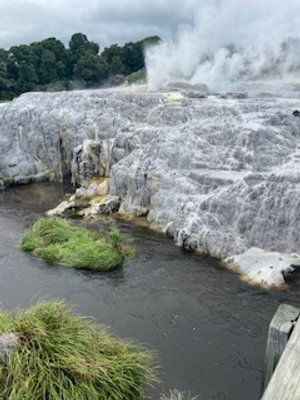#71 New Zealand: Open but not Quite Ready
Part 3 of my trip to Australia and New Zealand
New Zealand is a beautiful and small country noted for having more livestock animals than people living on it lands. Although the country is absolutely open for tourism, the ripple effects of the global pandemic are very much at play. In addition, Auckland was suffering from heavy rainfall and flooding during the summer. The week after we left at the beginning of February, 2023, a cyclone hit there.
In many of the smaller cities, the ocean-going cruise ships share port space with cargo container ships. At one or two of our advertised ports of call, our ship appears to have been “bumped” by container vessels. I am sure these actions are absolutely justified for practical and economic reasons. Those containers just may contain the necessities needed by the people of New Zealand. We lost our port calls in Dunedin and, in the capital, Wellington. (Viking Cruises did make compensatory offers to disappointed travelers.)
At the smaller ports like Lyttelton (Christchurch), Napier and Tauranga the cruise ships dock adjacent to active container loading sites in such a way that passengers are unable to walk from the cruise ship to the port for safety and security reasons. The ports set up shuttle busses but their very limited capacity restricts movement of passengers off the ship. We had no easy access on and off the ship which was disappointing, since the objective of this part of our trip was to spend more time visiting the port towns in New Zealand. Watching the blue cranes move the huge containers out of the storage are and onto the ship was quite fascinating and entertaining, but it was no the experience in New Zealand that I was hoping for.
The container shipyard at Lyttelton photo by Joan Naidorf
During our stop in Christchurch, we booked an excursion to the countryside to visit a (mostly) working sheep farm. The farmer and his wife augment their income by setting up their home to receive busloads of tourists. The energetic farmer presents a demonstration of his various sheep dogs and their herding skills. At his whistle commands, the dog runs straight up a very steep hillside to bring a group of merino sheep down to the group of gawkers. Of course, we could not help but draw comparison to a rather poorly trained and disobedient dog we have at home.
Working Dog at the sheep farm photo by Joan Naidorf
Then we went to his shearing shack and he demonstrated the shearing of a lamb. The farmer painted a rather bleak picture of the high costs of keeping and shearing sheep. One can understand why fine wool sweaters and coats command high prices at the boutiques.
Wooly New Zealanders photo by Joan Naidorf
We enjoyed a nice cup of tea with some nibbles in the garden of the farmhouse before we drove back to Christchurch. We were able to see the incredible surge of rebuilding in the city since the devastating earthquake of 2011. Many highly damaged buildings are still scaffolded or awaiting renovation. The city is most certainly rising from the dust of widespread destruction and is thriving.
We sailed away from Christchurch and made our way north along the eastern side of New Zealand. On the morning before disembarking in the town of Napier, the cruise officials announced that the guides of the local cruise company had all fallen ill (Covid?) and there were no others available. Like so many work places around the world, this company had no slack to cover for low staffing. The people hoping for a narration of the famous Art Deco buildings in Napier had to explore on their own.
Abbey Winery, Hawkes Bay, NZ photo by Joan Naidorf
We had an excursion planned to the nearby Hawke’s Bay wine country that went off as scheduled. We got a quick look at the Art Deco district of Napier as we exited town. After a short motorcoach ride through the verdant countryside, we arrived at the family vineyard of Brookfields. We were treated to an entertaining session with John, the marketing manager. We learned about this vineyard’s methods and varieties. He took particular pride in his small production Viogner. His estate bottled Shiraz was big and juicy. We bought a bottle to bring home packed in our luggage.
We motored a few miles to Abbey Cellars, another small, family owned operation. This property set the group up in their partly covered garden area to taste six of their wines. One of the owners presented the wines with little flare. We got short explanations and a nice charcuterie offering to enjoy with our wines. We particularly enjoyed their Chardonnay and picked up a bottle. No kangaroos in the vineyards here and no kangaroos in New Zealand.
On this sail away from the port of Napier, the sun was blazing and we finally got some hot summer weather. There was opportunity to try one of the ship’s pools and work on reading another book I picked up in the exchange library.
View of the Geothermal Field at Whakarewarewa Village
photo by Joan Naidorf
By the next morning, we reached the port of Tauranga. We chose an excursion to the geothermal area and Māori cultural show. The motor coach ride took about an hour and passed through miles and miles of tarpaulin covered Kiwi (the fruit) farms. From the website for our destination:
“Whakarewarewa Village is the legacy and home of the Tūhourangi Ngāti Wāhiao people, who have been sharing their unique way of life with visitors from all around the world for over two hundred years.
Able to trace their ancestry back to the Te Arawa people who first occupied the valley in 1325, generations of guides have been pioneering leaders of tourism in New Zealand. Since the early 1800’s they have been hosting and welcoming guests into their homes and backyards, sharing insights into Māori culture, as well as demonstrating the utilization of the natural geothermal wonders for cooking, bathing and heating. The continuing use of the natural geothermal landscape of the valley continues to delight and fascinate tourists visiting Whakarewarewa today.”
After arrival, as if we need it, they offer the group a buffet lunch. It wasn’t very good. From our seats, we could see the eruption of the main geyser which was quite good. After lunch we started our tour of the site. Our first stop was the enclosed Kiwi (the bird) habitat. We were told that when the fruit farmers wanted to rename the gooseberry fruit that grew so well in the New Zealand climate, they settled on the kiwi, since the fruit resembles the body of the native bird quite closely. They were not wrong.
Kiwi Bird
The facility acts as a sanctuary and works to breed the endangered birds. They have an artificially night light setup so that the nocturnal birds will be active for their human visitors. We got to see our first Kiwi birds and they looked incredibly like the echidnas we saw at the Featherdale sanctuary in Sydney. They burrow and sleep below ground. They lay their eggs in the burrow and it is the job of the male to incubate the eggs.
From the dark of the Kiwi house, we made our way to the sulfuric and steamy geothermal area. In an area reminiscent of sections of Yellowstone, numerous geysers and steam vents dot the landscape. Walkways and boardwalks keep visitors away from the boiling steam vents and fountains. As remnant of an active volcanic caldera, the site is well worth visiting.
Geyser Field photo by Joan Naidorf
With a short walk back to the base area, we concerned for a recreation of traditional Māori greetings and folk songs. The performance was held in an intricately carved traditional meeting house. The grounds feature many carvings and historic relics. The Māori hosts enthusiastically welcomed us in their language and in English.
The men and women performed songs and dances in their native language. A spirited war dance was performed with all the menacing grunts and facial expressions the men could muster. This family proudly share an interesting and enjoyable introduction to the music and traditions of their ancestors. I have seen many of these cultural performances over the years in various countries and I dare say that this was one of the best.
Maori Totems at the Village photo by Joan Naidorf
Much like the sad history of displacement and hostility towards the native population that occurred in North America, Australia and New Zealand have terrible histories of interaction and treatment of their indigenous populations. When Europeans landed, they brought deadly diseases that neary decimated the native people. Nearly every presentation or tour in Australia and New Zealand begins with a proclamation thanking and honoring the ancestors and people who were the native or first people of the land. It goes something like this:
“We acknowledge the Traditional Owners and Custodians of the land. We pay our respects to all First Nations people and acknowledge Elders past, present, and emerging.”
The sad acts of history are acknowledged (not white-washed) and gratitude is expressed before nearly every tour or event we attended. Many of the place names in New Zealand bear the original Māori names. Some places are labeled in both Māori and English.
The visit features an obligatory turn through the gift shop. The location has a nice variety of jewelry, clothing and artwork although not many produced locally. If there had been a good picture book with explanations, that would have been my preferred souvenir but I didn’t see one. My Visa card got a small workout there. My purchases completed a very fine visit to the Tauranga area.
We had our evening sail away towards our final stop: Auckland








